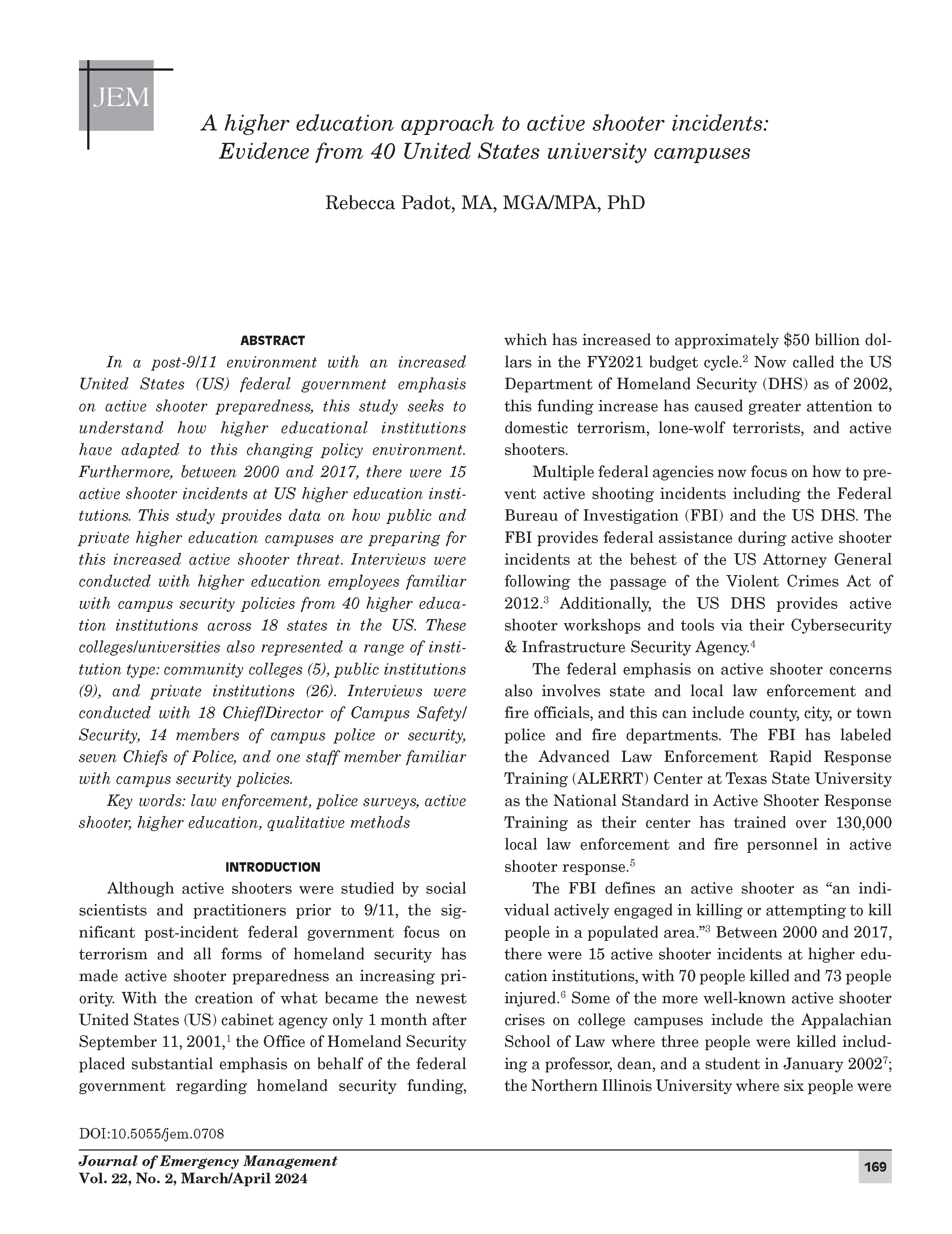A higher education approach to active shooter incidents: Evidence from 40 United States university campuses
DOI:
https://doi.org/10.5055/jem.0708Keywords:
law enforcement, police surveys, active shooter, higher education, qualitative methodsAbstract
In a post-9/11 environment with an increased United States (US) federal government emphasis on active shooter preparedness, this study seeks to understand how higher educational institutions have adapted to this changing policy environment. Furthermore, between 2000 and 2017, there were 15 active shooter incidents at US higher education institutions. This study provides data on how public and private higher education campuses are preparing for this increased active shooter threat. Interviews were conducted with higher education employees familiar with campus security policies from 40 higher education institutions across 18 states in the US. These colleges/universities also represented a range of institution type: community colleges (5), public institutions (9), and private institutions (26). Interviews were conducted with 18 Chief/Director of Campus Safety/ Security, 14 members of campus police or security, seven Chiefs of Police, and one staff member familiar with campus security policies.
References
Kettl DF: System under Stress: The Challenge to 21st Century Governance. 3rd ed. Washington DC: CQ Press, 2007.
US Department of Homeland Security: Fiscal year 2021: Budget in brief. 2021. Available at https://www.dhs.gov/publication/fy-2021-budget-brief. Accessed July 1, 2022.
Federal Bureau of Investigations: Active shooter resources. 2021. Available at https://www.fbi.gov/about/partnerships/office-ofpartner-engagement/active-shooter-resources. Accessed October 29, 2021.
US Department of Homeland Security: Active shooter preparedness. Cybersecurity & infrastructure security agency. 2021. Available at https://cisa.gov/active-shooter-preparedness. Accessed October 29, 2021.
ALERRT: Advanced law enforcement rapid response training: About ALERRT. 2021. Available at https://alerrt.org/about. Accessed October 29, 2021.
Roman J: The new normal. National Fire Protection Association Journal. 2018. Available at https://www.nfpa.org/News-and-Research/Publications-and-media/NFPA-Journal/2018/September-October-2018/Features/Campus-Active-Shooter. Accessed November 10, 2018.
Clines FX: 3 Slain at law school; student is held. The New York Times. 2002. Available at https://www.nytimes.com/2002/01/17/us/3-slain-at-law-school-student-is-held.html. Accessed January 17, 2022.
Cannon A: Aiming at students: The college gun violence epidemic. Citizens Crime Commission of New York City. 2016. Available at www.nyccrimecommission.org/pdfs/CCC-Aiming-at-studentscollege-shootings-Oct2016-pdf. Accessed October, 2016.
US Department of Homeland Security: Active shooter: How to respond. Available at https://www.dhs.gov/xlibrary/assets/active_shooter_booklet.pdf. Accessed June 8, 2020.
US Department of Labor: How to plan for workplace emergencies and evacuations. Occupational safety and health administration. 2001. Available at https://www.osha.gov/Publications/osha3088.pdf. Accessed March 12, 2020.
Sinai J: Active Shooter: A Handbook on Prevention. 2nd ed. Alexandria, VA: ASIS International, 2016.
Indiana University Police Department: Safety guidelines for armed subjects, active shooter situations. 2007. Available at https://www2.indstate.edu/pubsafety/docs/active-shooter.pdf. Accessed February 28, 2015.
Cappellan J: Lone wolf terrorist or deranged shooter? A study of ideological active shooter events in the United States, 1970-2014. Conflict Terrorism. 2015; 38(6): 395-413. DOI: 10.1080/1057610X.2015.1008341. DOI: https://doi.org/10.1080/1057610X.2015.1008341
Lankford A: Mass shooters in the USA, 1966-2010: Differences between attackers who live and die. Justice Q. 2015; 32(2): 360-379. DOI: 10.1080/07418825.2013.806675. DOI: https://doi.org/10.1080/07418825.2013.806675
Klarevas L: Rampage Nation: Securing America from Mass Shootings. Amherst, NY: Prometheus Books, 2016.
Anderson CA, Murphy CR: Violent video games and aggressive behavior in young women. Aggr Behav. 2003; 29(5): 423-429. DOI: 10.1002/ab.10042. DOI: https://doi.org/10.1002/ab.10042
Langman PE: Why kids kill? Inside the Minds of School Shooters. New York, NY: Palgrave, MacMillan, 2009.
Larkin RW: Comprehending Columbine. Philadelphia, PA: Temple University Press, 2007. DOI: https://doi.org/10.26530/OAPEN_626973
Browne KD, Hamilton-Giachritsis C: The influence of violent media on children and adolescents: A public-health approach. Lancet. 2005; 365(9460): 702-710. DOI: 10.1016/S0140-6736(05)66372-6. DOI: https://doi.org/10.1016/S0140-6736(05)17952-5
Reiner R: Media-made criminality: The representation of crime in the mass media. In Maguire M, Morgan R, Reinder R (eds.): The Oxford Handbook of Criminology. Oxford: Oxford University Press, 2007.
Fast J: Ceremonial Violence: A Psychological Explanation of School Shootings. New York: The Overlook Press, 2008.
Newman KS, Fox C, Roth W, et al.: Rampage: The Social Roots of School Shootings. New York: Basic Books, 2004.
Rocque M: Exploring school rampage shootings: Research, theory, and policy. Soc Sci J. 2012; 49: 304-313. DOI: 10.1016/j.soscij.2011.11.001. DOI: https://doi.org/10.1016/j.soscij.2011.11.001
Baird AA, Roellke EV, Zeifman D: Alone and adrift: The association between mass school shootings, school size, and student support. Soc Sci J. 2017; 54: 261-270. DOI: 10.1016/j.soscij.2017.01.009. DOI: https://doi.org/10.1016/j.soscij.2017.01.009
Fox JA, Savage J: Mass murder goes to college: An examination of changes on college campuses following Virginia tech. Am Behav Sci. 2009; 52(10): 1465-1485. DOI: 10.1177/0002764209332558. DOI: https://doi.org/10.1177/0002764209332558
De Angelis J, Benz TA, Gillham P: Collective security, fear of crime, and support for concealed firearms on a university campus in the Western United States. Crim Justice Rev. 2017; 42(1): 77-94. DOI: 10.1177/0734016816686660. DOI: https://doi.org/10.1177/0734016816686660
National Conference of State Legislatures: Guns on campus: Overview. National conference of state legislatures. 2015. Available at http://www.ncsl.org/research/education/guns-on-campus-overview.aspx. Accessed 2017.
Han W, Ada S, Sharman R, et al.: Campus emergency notification systems: An examination of factors affecting compliance with alerts. MIS Q. 2015; 39(4): 909-929. DOI: https://doi.org/10.25300/MISQ/2015/39.4.8
Woodward VH, Pelletier D, Griffin OH, et al.: University policies and programs for crime prevention and awareness: An examination of online reports and resources. Crim Justice Rev. 2016; 41(2): 140-158. DOI: 10.1177/0734016816634783. DOI: https://doi.org/10.1177/0734016816634783
Sudlowski ML, Lazarus P: Contemporary responses to violent attacks on college campuses. J School Violen. 2011; 10(4): 338-354. DOI: 10.1080/15388220.2011.602601. DOI: https://doi.org/10.1080/15388220.2011.602601
Myers K: Plan, prepare, and respond for an active shooter situation: An investigation of public safety director’s at private four-year colleges and universities. Dissertation Abstracts International (Publication No. 10099641). 2016.
Myers K: Higher education institutions: Complex and underprepared for active-shooter situations. Campus Law Enforcement J. 2017; 47(1): 35.
US Census: Census regions and divisions of the United States. 2021. Available at https://www2.census.gov/geo/pdfs/maps-data/maps/reference/us_regdiv.pdf. Accessed July 1, 2022.
Indiana University Center for Postsecondary Research: The Carnegie Classification of Institutions of Higher Education. Bloomington, IN: Indiana University Center for Postsecondary Research, 2015.
Thompson A, Price JH, Mrdjenovich AJ, et al.: Reducing firearm- related violence on college campuses—Police chief’s perceptions and practices. J Am College Health. 2009; 58(3): 247-254. DOI: 10.1080/07448480903295367. DOI: https://doi.org/10.1080/07448480903295367
Doss K, Shepherd C: Active Shooter: Preparing for and Responding to a Growing Threat. Kidlington, Oxford: Elsevier, 2015.

Published
How to Cite
Issue
Section
License
Copyright 2007-2025, Weston Medical Publishing, LLC and Journal of Emergency Management. All Rights Reserved.





